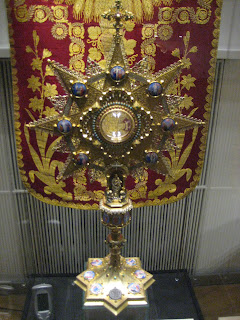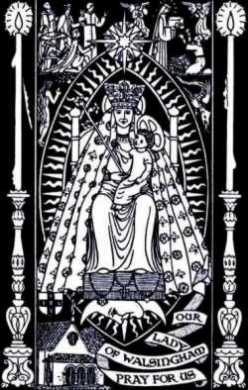Red Chasuble and Monstrance.


 Really absolutely horrible monstrance, but look at the bling!
Really absolutely horrible monstrance, but look at the bling! The rationale is an episcopal humeral, a counterpart of the pallium, and like it worn over the chasuble. At the present time it is only used by the Bishops of Eichstätt, Paderborn, [Nancy] Toul, and Cracow. As worn by the Bishops of Eichstätt, Paderborn, and Toul, the rationale is in the form of a humeral collar, ornamented in the front and back with appendages. The one used by the Bishop of Cracow is made of two bands crossing the shoulder and joined at the breast and at the back, having the appearance of a discoid connected by medallions.... It originated undoubtedly in the pomp developed in episcopal vestments during the tenth century, and took its name from the breast ornament of the Jewish high-priest.
The rationale is an episcopal humeral, a counterpart of the pallium, and like it worn over the chasuble. At the present time it is only used by the Bishops of Eichstätt, Paderborn, [Nancy] Toul, and Cracow. As worn by the Bishops of Eichstätt, Paderborn, and Toul, the rationale is in the form of a humeral collar, ornamented in the front and back with appendages. The one used by the Bishop of Cracow is made of two bands crossing the shoulder and joined at the breast and at the back, having the appearance of a discoid connected by medallions.... It originated undoubtedly in the pomp developed in episcopal vestments during the tenth century, and took its name from the breast ornament of the Jewish high-priest. The Krakow Ornat, one of the finest pieces of needlework in the world.


Before I start posting about the many Baroque Churches in Krakow, which i will try and spread out over a couple of weeks, so as not to lead to Baroqueitis, here are some pictures from the Archdiocesan museum. You will know if you have Baroqueitis by two main signs, firstly, you will start growing long hair and your limbs will begin a gilding process, although advanced cases find an insatiable urge to balance, cherub like, from tall buildings and altars, smiling and covering their genitalia with gold cloths. The only cure is to attend Mass every Sunday in a concrete, modern Church. Priests who catch this disease must wear albs that do not fit them and cheap, unlined polyester chasubles until the signs have gone. That would explain why Polish priests wear them anyway..... apart from in St Mary's Basilica, happily, where the full Baroque experience can be found, right down to such magnificant period detailing as aged priests peering out of confessionals with their birettas on, sporting perfect aquiline noses.





_Black_s_s_s_s_s.jpg)
